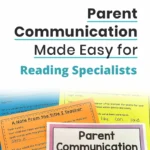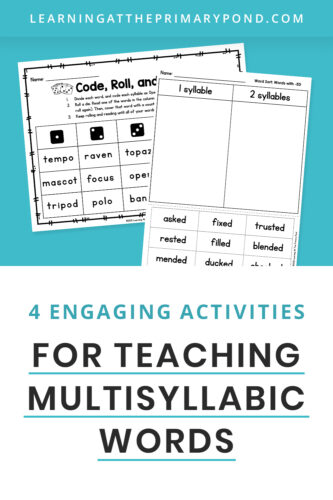It can be really overwhelming to realize that your child is behind in reading. You start to ask yourself tons of questions – “What should I do? What is his/her teacher doing? Is there something I should have been doing to avoid this? Is there a bigger issue going on here?”
It is completely normal to have these worries. You only want the best for your child, and reading plays a HUGE role in their success in school and their future as a whole!
But I also want to give you a little bit of encouragement. Because you’re reading this post, that tells me that you are invested in helping your child be successful. You want to help them – and trust me, you absolutely CAN!
No matter what your own background knowledge is (maybe you know a lot about the ins and outs of reading or maybe you know nothing at all!) and no matter what your schedule may be like (you could be a homeschooling parent or you could have a full-time job outside of the home), there are absolutely steps you can take to help your struggling reader.
In fact, you are the BEST person to be the advocate for your child! So in this post, I want to empower you by sharing 3 specific things to do if your child is behind in reading.
You can also click here for a completely free parent guide called “Where to Start when Helping Your Struggling Reader,” which is referenced throughout the blog post.

Tip #1
First and foremost, it’s important to assess your own child – to find out what skills they need to work on.
This may seem foreign to you because you may not have given your child a test before! But instead of thinking of this as a test, think of it as an opportunity for you to learn more about your child’s needs.
The majority of kids who are struggling to decode (read) words need more work with phonics. So a phonics assessment will allow you to see which particular phonics skills they are strong in and which ones they need more support with.
With strong phonics knowledge, students are able to decode more words. As their decoding improves, they become more fluent readers. And as their fluency improves, their reading comprehension will likely grow, too!
In my Free Parent Guide “Where to Start when Helping Your Struggling Reader”, we have you assess your child’s phonics knowledge by testing:
- Their letter sounds knowledge (you can skip this if your child is already reading chapter books)
- Their ability to spell words
- Their ability to decode (read) words
When giving this assessment, you’ll print out all of the provided materials. This will include a scoring sheet so that you can record your child’s results. When you present this to your child, say something like: “I can’t wait for you to show me what you can do!” versus “This test is going to show me what you don’t know.” Also, plan to let your child take a break after each component of the assessment!
For the letter sounds portion, place the letter sheet in front of your child. Point to each letter and ask, “What sound does this letter make?” If they aren’t sure, don’t provide help; instead, encourage them to do their best! Similarly, don’t tell them if they got a sound correct or not. This could just make them nervous.

Next, for the spelling test, your child will need a blank piece of a paper and a pencil. You will have the “Diagnostic Spelling Test” sheet in front of you (but you won’t show it to your child). One at a time, you’ll read a word, read the example sentence with a word, and then have your child spell the word on their own paper.
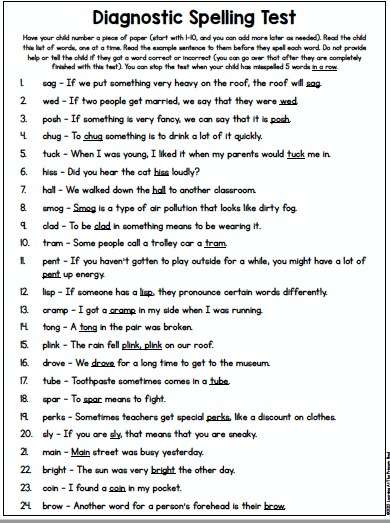
To score this section, you’ll wait until you’ve gone through the entire test with your child. (There is guidance included about when to stop the test if they keep making mistakes). When it’s time to score, give them a checkmark if they spelled the underlined portion of the word correctly.
For instance, if they spelled the word “sag” like this – “cag” – you’d still give them a checkmark because they got the middle vowel “a” correct. (Here, it’d be important to just make a little note that they may need work on their “s” and “c” sounds.)
This might sound like a lot, but don’t worry – all of these directions are written out for you in the free parent guide, “Where to Start when Helping Your Struggling Reader.”
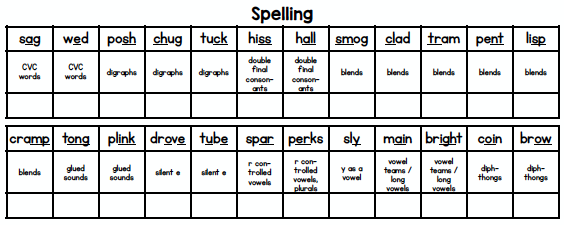
Last, with the word reading test, show students the “Diagnostic Word Reading” sheet, p. 1 to start. If your child might be overwhelmed by the big list, you can cover up some of the words with a blank sheet of paper.
Simply have your child read the words, moving from top to bottom, left to right. There is guidance included in the free parent guide about when to discontinue the test if they are making lots of mistakes. If your child gets through p. 1 of this part, move onto p. 2 (not pictured here).
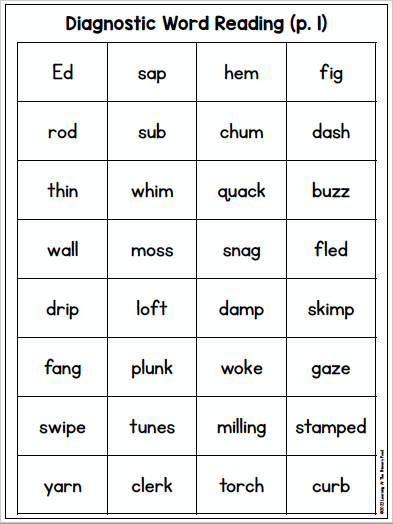
As with the other components of the assessment, don’t provide help. Encourage your child to say the sounds and blend instead of just guessing at the words. As they’re reading, put a checkmark on your scoring sheet if they get a word correct.
Tip #2
After you’ve assessed and finished scoring, your next step is to pinpoint the skills your child needs to work on. To do this, you’ll want to have a print-out of the “Phonics Skills Sequence” page. Remember, this is all included in the completely free resource “Where to Start when Helping Your Struggling Reader.”
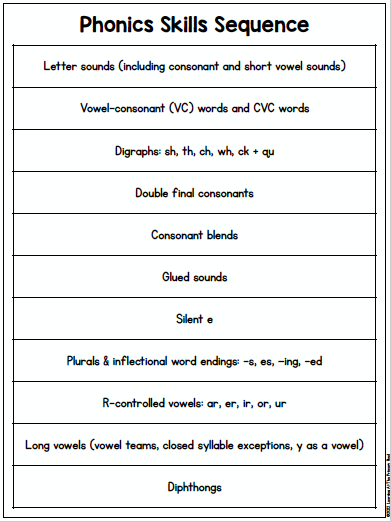
I think it’s easiest to place your completed scoring sheet next to this “Phonics Skills Sequence” sheet.
Take a look at the scoring sheet to see which phonics skills your child missed. The labels – i.e. CVC words, silent e, vowel teams, etc. – will show you exactly what skills they are. Circle or highlight these same skills on the sequence sheet pictured above. For instance, if your child missed the word “fang” on the assessment, you’d highlight “glued sounds” on the sequence itself.
Something you may notice is that your child was able to read more difficult words than they could actually spell. This is totally normal! You’ll want to make note of this on the sequence sheet – so you remember what words your child struggled with in terms of reading and what they struggled with in terms of spelling.
Tip #3
After you’ve gone through these two steps, it’s now time to have your child practice reading and writing words with those particular phonics skills!
You’ll begin with the skill they struggled with that is closest to the top of the “Phonics Skills Sequence” page. This will be the easiest skill.
Developmentally speaking, they’ll need to become proficient with those easier skills (like letter sounds and VC/CVC words) before they will have success with the more difficult phonics patterns (such as digraphs and blends).
When it comes to reading and writing practice, your child should be working with lots of words with that particular pattern. Once they’re able to correctly read and spell 80-90% of words with that pattern, you can move on to the next skill in the sequence.
I have an entire list of additional resources you can use to learn more and teach each specific phonics skill! This is also included in the free resource.
Conclusion
Again, I want to commend you for taking the first steps in helping your struggling reader!
As you know, if your child is behind in reading, it doesn’t just affect “reading” time – it may also make things difficult during math (reading word problems), writing (putting thoughts down on paper), social studies (navigating information in a textbook), and the list goes on and on.
So bravo to you for being an advocate for your child!
Remember, if you haven’t yet, you can download the free parent guide here.
And if you want to learn how to get your struggling reader get back on track, read more about our Rising Readers coaching program here.


